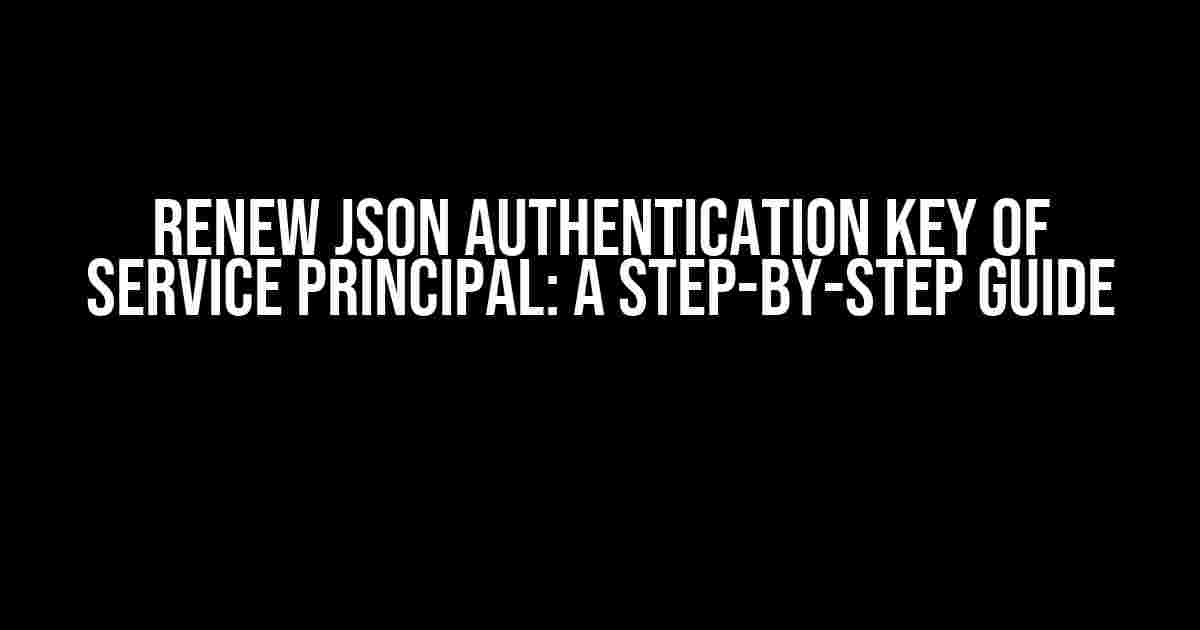Are you tired of dealing with expired authentication keys for your Azure Service Principal? Do you want to ensure seamless authentication and authorization for your Azure resources? Look no further! In this article, we’ll dive into the world of JSON authentication keys and show you how to renew them with ease.
What is a Service Principal?
A Service Principal is an identity created for a service or application in Azure Active Directory (AAD). It allows the service to access Azure resources on behalf of the user, without the need for a user’s credentials. Think of it as a robotic identity that can perform tasks independently, without human intervention.
Why Do We Need Authentication Keys?
Authentication keys, also known as client secrets, are used to authenticate the Service Principal to Azure resources. They’re essentially passwords that grant access to the resources. Without these keys, your Service Principal won’t be able to access the resources it needs to perform its tasks.
The Problem: Expired Authentication Keys
Authentication keys have an expiration date, typically set to 1 or 2 years. When they expire, your Service Principal will no longer be able to access the Azure resources. This can lead to service disruptions, errors, and even security breaches.
The Solution: Renewing the JSON Authentication Key
Renewing the JSON authentication key is a straightforward process that ensures continued access to Azure resources. In this section, we’ll guide you through the steps to renew the key.
Step 1: Install the Azure CLI
Before we begin, make sure you have the Azure CLI installed on your machine. If you don’t have it installed, follow these steps:
- Open a terminal or command prompt.
- Run the following command:
curl -sL https://aka.ms/InstallAzureCLIDeb | sudo bash(for Linux or macOS) - Or, run the following command:
Invoke-WebRequest -Uri https://aka.ms/installazurecliwindows -OutFile .\AzureCLI.msi; Start-Process .\AzureCLI.msi(for Windows)
Step 2: Login to Azure
az loginStep 3: Create a New JSON Authentication Key
az ad sp credential reset --name --query password --output tsv Step 4: Copy the New JSON Authentication Key
az ad sp credential reset --name --query password --output tsv | clip Step 5: Update the Service Principal Configuration
az ad sp update-for-rbac --name --client-secret Troubleshooting Common Issues
Renewing the JSON authentication key can sometimes throw errors. Here are some common issues you might encounter:
| Error | Solution |
|---|---|
| Invalid client secret | Make sure the new JSON authentication key is correctly copied and pasted. Try updating the Service Principal configuration again. |
| Azure CLI not installed | Install the Azure CLI following the instructions in Step 1. |
| Authentication failed | Check your Azure credentials and try logging in again. Ensure you have the correct permissions to update the Service Principal. |
Best Practices for Managing Service Principal Authentication Keys
To avoid service disruptions and security breaches, follow these best practices for managing Service Principal authentication keys:
- Set reminders for authentication key expiration dates.
- Use a password manager to securely store and generate strong authentication keys.
- Limit access to the Service Principal configuration to authorized personnel.
- Regularly review and update the Service Principal configuration to ensure it aligns with your organization’s security policies.
Conclusion
Renewing the JSON authentication key for your Azure Service Principal is a crucial task to ensure continued access to Azure resources. By following the steps outlined in this article, you’ll be able to renew the key and avoid service disruptions. Remember to follow best practices for managing authentication keys to maintain the security and integrity of your Azure resources.
Don’t let expired authentication keys hold you back! Take control of your Azure Service Principal today and ensure seamless authentication and authorization for your Azure resources.
Frequently Asked Question
Are you having trouble with your Service Principal’s JSON authentication key? Don’t worry, we’ve got you covered! Here are some frequently asked questions and answers to help you renew your JSON authentication key.
Why do I need to renew my JSON authentication key?
You need to renew your JSON authentication key to maintain the security of your Azure resources. The key is valid for a limited time, and when it expires, you’ll no longer be able to authenticate to Azure using your Service Principal. Renewing the key ensures uninterrupted access to your resources.
How often should I renew my JSON authentication key?
It’s recommended to renew your JSON authentication key every 6-12 months or as per your organization’s security policy. Regular renewal helps prevent unauthorized access to your Azure resources and ensures compliance with security best practices.
What happens if I don’t renew my JSON authentication key?
If you don’t renew your JSON authentication key, you’ll no longer be able to authenticate to Azure using your Service Principal. This can lead to interruptions in your applications and services, and you may experience errors or failures when trying to access your Azure resources.
Can I automate the renewal of my JSON authentication key?
Yes, you can automate the renewal of your JSON authentication key using Azure CLI or PowerShell scripts. These scripts can be scheduled to run periodically, ensuring your key is renewed before it expires.
What are the steps to renew my JSON authentication key?
To renew your JSON authentication key, follow these steps: Navigate to the Azure portal, go to Azure Active Directory, select App registrations, choose your Service Principal, and click on Certificates & secrets. Then, click on New client secret, add a description, and set an expiration date. Finally, click Add to create a new JSON authentication key.

